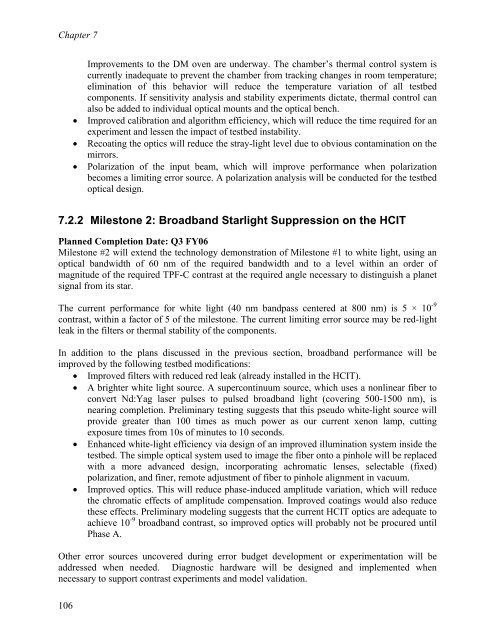TPF-C Technology Plan - Exoplanet Exploration Program - NASA
TPF-C Technology Plan - Exoplanet Exploration Program - NASA
TPF-C Technology Plan - Exoplanet Exploration Program - NASA
Create successful ePaper yourself
Turn your PDF publications into a flip-book with our unique Google optimized e-Paper software.
Chapter 7<br />
Improvements to the DM oven are underway. The chamber’s thermal control system is<br />
currently inadequate to prevent the chamber from tracking changes in room temperature;<br />
elimination of this behavior will reduce the temperature variation of all testbed<br />
components. If sensitivity analysis and stability experiments dictate, thermal control can<br />
also be added to individual optical mounts and the optical bench.<br />
• Improved calibration and algorithm efficiency, which will reduce the time required for an<br />
experiment and lessen the impact of testbed instability.<br />
• Recoating the optics will reduce the stray-light level due to obvious contamination on the<br />
mirrors.<br />
• Polarization of the input beam, which will improve performance when polarization<br />
becomes a limiting error source. A polarization analysis will be conducted for the testbed<br />
optical design.<br />
7.2.2 Milestone 2: Broadband Starlight Suppression on the HCIT<br />
<strong>Plan</strong>ned Completion Date: Q3 FY06<br />
Milestone #2 will extend the technology demonstration of Milestone #1 to white light, using an<br />
optical bandwidth of 60 nm of the required bandwidth and to a level within an order of<br />
magnitude of the required <strong>TPF</strong>-C contrast at the required angle necessary to distinguish a planet<br />
signal from its star.<br />
The current performance for white light (40 nm bandpass centered at 800 nm) is 5 × 10 -9<br />
contrast, within a factor of 5 of the milestone. The current limiting error source may be red-light<br />
leak in the filters or thermal stability of the components.<br />
In addition to the plans discussed in the previous section, broadband performance will be<br />
improved by the following testbed modifications:<br />
• Improved filters with reduced red leak (already installed in the HCIT).<br />
• A brighter white light source. A supercontinuum source, which uses a nonlinear fiber to<br />
convert Nd:Yag laser pulses to pulsed broadband light (covering 500-1500 nm), is<br />
nearing completion. Preliminary testing suggests that this pseudo white-light source will<br />
provide greater than 100 times as much power as our current xenon lamp, cutting<br />
exposure times from 10s of minutes to 10 seconds.<br />
• Enhanced white-light efficiency via design of an improved illumination system inside the<br />
testbed. The simple optical system used to image the fiber onto a pinhole will be replaced<br />
with a more advanced design, incorporating achromatic lenses, selectable (fixed)<br />
polarization, and finer, remote adjustment of fiber to pinhole alignment in vacuum.<br />
• Improved optics. This will reduce phase-induced amplitude variation, which will reduce<br />
the chromatic effects of amplitude compensation. Improved coatings would also reduce<br />
these effects. Preliminary modeling suggests that the current HCIT optics are adequate to<br />
achieve 10 -9 broadband contrast, so improved optics will probably not be procured until<br />
Phase A.<br />
Other error sources uncovered during error budget development or experimentation will be<br />
addressed when needed. Diagnostic hardware will be designed and implemented when<br />
necessary to support contrast experiments and model validation.<br />
106
















